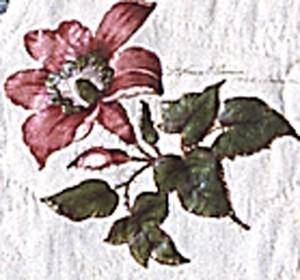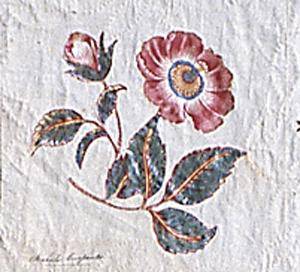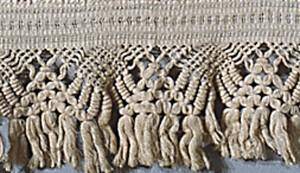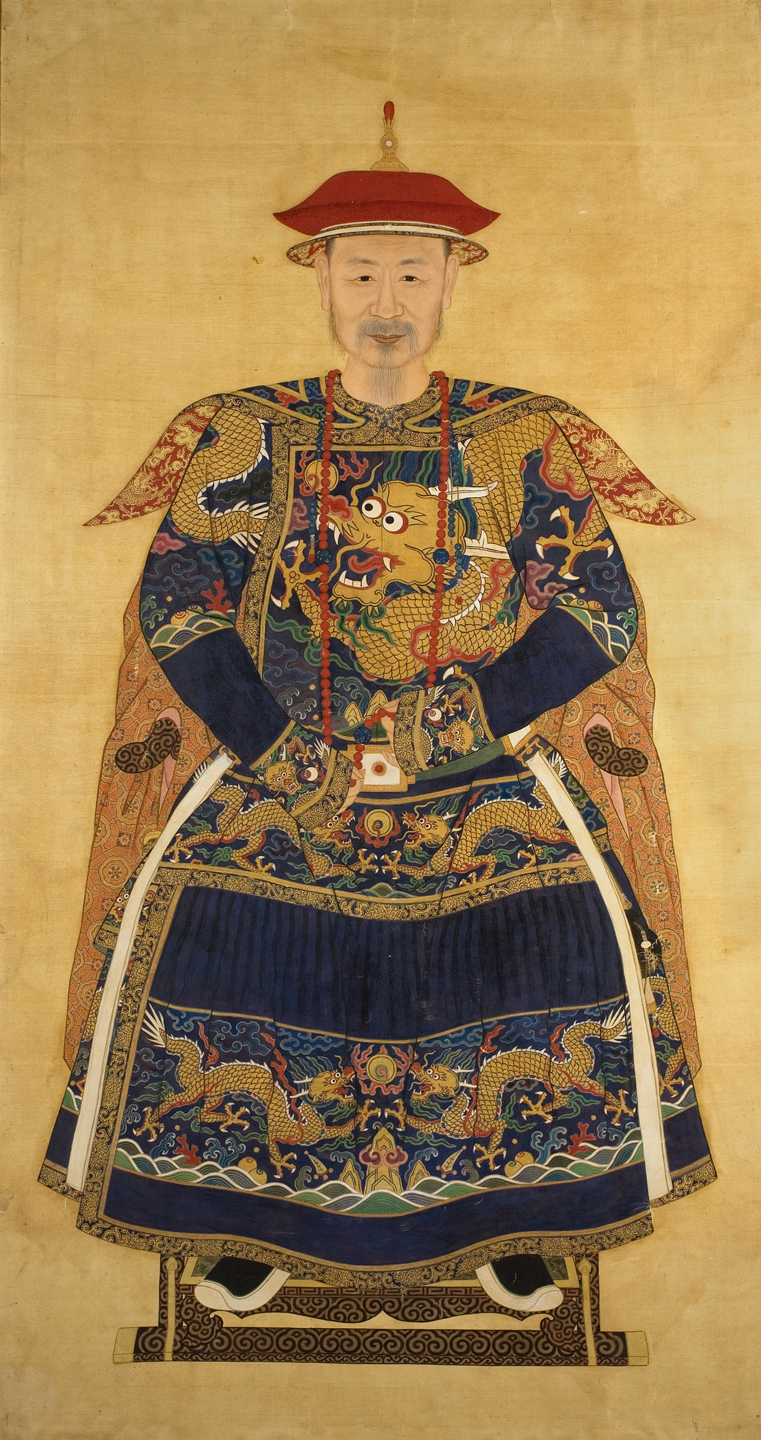After learning the importance of positive and negative space, students will carve their own designs in a soft cut linoleum block. Taking inspiration from the Pratt Family Album Quilt, the students will share designs with each other and create their own prints and quilts that displays creativity, teamwork, and personal expression.
Students will be able to:
- analyze and evaluate the Pratt Family Album Quilt for its defining characteristics;
- carve an original design into a soft cut linoleum block;
- work cooperatively with classmates in trading designs and creative ideas; and
- create a quilt that displays creativity, teamwork, and personal expression.
Lesson
Day 1
- Warm-up: Display the Rubin’s Vase optical illusion. Give the students time to see both images: the two faces looking at each other (in black) and the vase (in white). Have the students focus on the faces and explain that the black area is the positive space, the actual object being observed, and the white is the negative space, the space between and around the objects. Now have them focus on the vase. This time, the white area is the positive space, the object being focused on, and the black is the negative space, the space around the object.
- Show the class the Pratt Family Album Quilt and ask the students discuss what they see. As they’re talking, point out elements such as the printed fabric, borders, and hand drawn details. Make sure to point out the carefully arranged flowers in the quilt blocks. Using the About the Art section, explain that these flowers are individually cut out from printed fabric and stitched to the background fabric. Layering one fabric on top of another is a technique known as appliqué.
- Explain to the students that in this lesson they will each be carving a design that includes both positive and negative space into a linoleum block and then creating their own unique printed fabric.
- Distribute drawing paper and pencils and let the students begin making preliminary sketches of the design they would like to make into a print. Remind them that in order to create a design or object that will print successfully, they need to include both positive and negative space. On the sketches, have them color in areas of positive space with green and areas of negative space with red so they can have a visual of which areas will be carved out.
- Once the sketches are complete, pass out the linoleum blocks and have the students begin transferring their object or design by re-drawing it on the block. Make sure they also transfer the red and green colors that will help them know which areas are meant to be carved.
- Distribute carving tools and, if necessary, demonstrate how to carefully carve away layers of the linoleum. If students are new to this process, here are a few tips:
- Mark the design clearly after transferring the outline. Color in the negative space (the space around the object) in red and the positive space (the object or design itself) in green. Use this as a guide while you carve and only carve out one color.
- Always carve away from yourself—not just away from your hand, but away from your body and fingers, too.
- Carve away layers a little at a time instead of trying to take out big chunks.
- Remember, lines that are too fine won't show up in a print.
Day 2
- Warm up: Display the Pratt Family Album Quilt again for the students to see. Explain that each square in the quilt was contributed by a different person who wanted to wish the Pratt’s a happy marriage. Today, the students will do a similar exchange, swapping their linoleum block designs with those of their classmates as a way of displaying friendship.
- Have the students make a print from their own linoleum block on a fabric or paper square. To begin, distribute the brayers or paintbrushes for applying paint, assorted colors of paint, and fabric squares. Demonstrate to the students how to carefully roll (if using brayers) or paint (if using paintbrushes) the linoleum block with the desired colors, place the block on the fabric square, and gently press to make sure the paint is transferred. Have them wipe excess paint off the block with a paper towel.
- Gather all the linoleum blocks in the center of the room. Each student will get to choose five different designs (or more if you add additional squares of fabric) to make prints for their final quilt. Allow them time to work cooperatively as a class, sharing designs and creative ideas.
- When each student has six prints, have them walk around the room with permanent markers and sign their names to all of the prints of their own design.
- Use fabric glue to piece together the prints. Add ribbon, lace, or paper strips to create borders around the square if desired. Display the students’ quilts around the room as a reminder of class teamwork and unity!
Materials
- Copy of Rubin’s Vase optical illusion
- Drawing paper and pencils for preliminary sketches
- One soft cut linoleum block per student (these can be ordered from the Dick Blick catalogue or purchased through a local art store)
- Carving tools for the linoleum blocks (these can be purchased through the same outlets as the soft cut linoleum blocks)
- Cookie trays or large paper plates for distributing ink or paint
- Brayers (small rollers for ink) or paintbrushes
- Printing inks or paints in assorted colors (poster paint can be thickened with a little glue)
- Permanent markers
- Paper towels
- Fabric glue if using fabric; glue if using paper
- Lace, ribbon, or strips of paper to create borders
- Six squares of fabric (muslin if possible) or paper, approximately 10½ x 12 inches, for each student’s quilt (additional squares can be added to make quilts larger)
- A great source for fabrics and art materials in Denver is Resource Area for Teaching
- About the Art section on Pratt Family Album Quilt
- One color copy of the quilt for every four students, or the ability to project the image onto a wall or screen
Standards
- Visual Arts
- Invent and Discover to Create
- Observe and Learn to Comprehend
- Relate and Connect to Transfer
- Envision and Critique to Reflect
- Language Arts
- Oral Expression and Listening
- Research and Reasoning
- Writing and Composition
- Reading for All Purposes
- Collaboration
- Critical Thinking & Reasoning
- Information Literacy
- Invention
- Self-Direction
Album Quilt
- multiple
This signature quilt was made as a wedding present for Anna Eliza Pratt (1823–1895), granddaughter of one of Philadelphia’s leading merchants, on the occasion of her marriage to Lewis Perrine. Each well-wisher whose name appears on the quilt gifted a block (an individual square of quilted fabric), but the identity of the skilled maker is still in question. We do know that the quilt was made in the Delaware River Valley and is dated September 15, 1842 (a date of 1843 also appears on the quilt). Each block contributed to the quilt is different. To create bouquets, flowers were cut out from printed cottons, assembled into a design, and hand-stitched to the background fabric. This method of stitching one piece of fabric onto another is called appliqué. The Pratt Family Album Quilt displays elaborate cutting and appliqué techniques, and many of the blocks have fine details drawn in pen and ink.
Signature quilts were made to commemorate an event such as a wedding, birth, or major move. This quilt was made to celebrate the marriage of Anna and Lewis Perrine. Signature quilts became popular around the 1840s. When making a signature quilt, friends and family would sign their names and possibly a date, location, religious verse, or other token of remembrance as a way of expressing friendship for the recipient, not as a way of identifying their own workmanship. The names on the quilt were meant to remind the recipients of their friends and family; signing the quilt was like signing a card today. Women would sign with ink, demonstrating their elegant handwriting and creating a diverse array of handwriting styles on the quilt. It was very difficult to write on cloth, however, so signatures were not always written by the person named. Sometimes signatures were written by a professional calligrapher, and sometimes simply by the person with the best handwriting.
Details

Central Block
The block in the center of the quilt is larger than the rest and contains a large bouquet of flowers with four smaller flowers in each corner. Also in the center is a butterfly and what look like two hummingbirds. The large bouquet is set on white cotton with interlacing circle, leaf, and line stitches.

Appliqué
Notice how flowers are cut out from printed fabric and stitched to the background fabric—a technique known as appliqué. The appliqué technique used on this quilt involves printed fabric and is referred to as broderie perse [broe-dair-ee pearz] (Persian embroidery).

Hand-drawn Details
Some of the finely detailed leaves, flowers, and what appear to be sheaves of grain were hand-drawn with ink. All of the hand-drawn details are monochrome (one color) and surround the more colorful bouquets.

Signatures
The signatures of well-wishers can be seen in the corners of many of the blocks.

Borders
There are four borders, or outlines, on this quilt. The inside border that surrounds the individual blocks is the narrowest border. It is made from a flower and lattice fabric and applied whole and not as cut-outs. The next border is made up of printed fabric that is cut and appliquéd. Outside of the appliqué border is a fabric border of flowers and leaves. The fabric for this border is used whole and not as cut-outs. The final border, which surrounds the entire quilt, is made of lace.
Funding for object education resources provided by a grant from the Morgridge Family Foundation. Additional funding provided by the William Randolph Hearst Endowment for Education Programs, and Xcel Energy Foundation. We thank our colleagues at the University of Denver Morgridge College of Education.
The images on this page are intended for classroom use only and may not be reproduced for other reasons without the permission of the Denver Art Museum. This object may not currently be on display at the museum.







